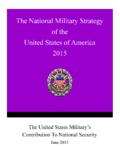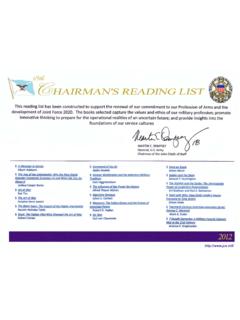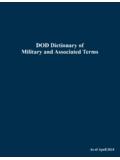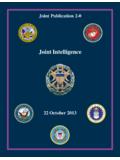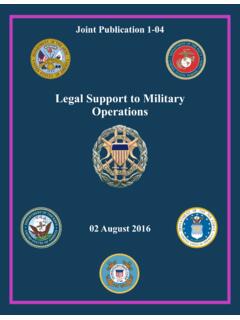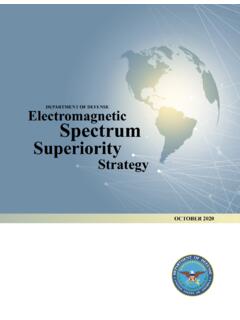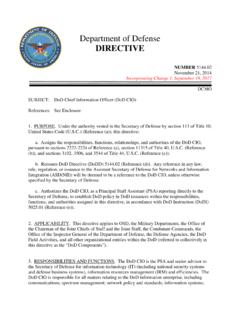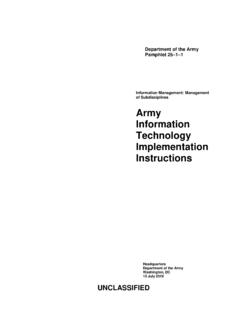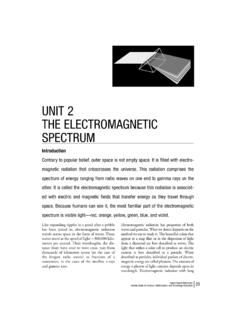Transcription of Joint Electromagnetic Spectrum Operations
1 22 Ma y 2020 Joint Electromagnetic Spectrum OperationsJoint Publication 3-85 i PREFACE 1. Scope This publication provides fundamental principles and guidance for planning, executing, and assessing Joint Electromagnetic Spectrum Operations across the competition continuum. 2. Purpose This publication is the Chairman of the Joint Chiefs of Staff (CJCS) official advice concerning Joint Electromagnetic Spectrum Operations and provides considerations for military interaction with governmental and nongovernmental agencies, multinational forces, and other interorganizational partners. It does not restrict the authority of the Joint Force Commander (JFC) from organizing forces and executing the mission in a manner the JFC deems most appropriate to ensure unity of effort.
2 3. Application a. Joint doctrine established in this publication applies to the Joint Staff, commanders of combatant commands, subordinate unified commands, Joint task forces, subordinate components of these commands, the Services, the National Guard Bureau, and combat support agencies. b. This doctrine constitutes official advice concerning the enclosed subject matter; however, the judgment of the commander is paramount in all situations. c. If conflicts arise between the contents of this publication and the contents of Service publications, this publication will take precedence unless the CJCS, normally in coordination with the other members of the Joint Chiefs of Staff, provides more current and specific guidance. Commanders of forces operating as part of a multinational (alliance or coalition) military command should follow multinational doctrine and procedures ratified by the United States.
3 For doctrine and procedures not ratified by the United States, commanders should evaluate and follow the multinational command s doctrine and procedures, where applicable and consistent with US law, regulations, and doctrine. For the Chairman of the Joint Chiefs of Staff: DANIEL J. O DONOHUE Lieutenant General, USMC Director, Joint Force Development Preface ii JP 3-85 Intentionally Blank iii TABLE OF CONTENTS EXECUTIVE SUMMARY ..v CHAPTER I OVERVIEW OF Joint Electromagnetic Spectrum Operations Introduction .. I-1 Electromagnetic Environmental Effects .. I-11 Relationship to Joint Functions .. I-12 CHAPTER II ORGANIZING FOR Joint Electromagnetic Spectrum Operations Introduction ..II-1 Responsibilities ..II-1 Organization ..II-10 Service Support.
4 II-17 Intelligence Support Organizations ..II-22 Multinational Force Organization ..II-23 CHAPTER III PLANNING Joint Electromagnetic Spectrum Operations Introduction .. III-1 Planning Process .. III-1 Planning Considerations .. III-10 Planning Considerations in Multinational Operations .. III-17 Interorganizational Planning Considerations .. III-21 CHAPTER IV CONDUCTING Joint Electromagnetic Spectrum Operations Introduction .. IV-1 Execution .. IV-1 Assessment .. IV-4 APPENDIX A Electromagnetic Spectrum management .. A-1 B Electromagnetic Warfare Activities ..B-1 C Notional Joint Electromagnetic Spectrum Operations Appendix ..C-1 D Organizations Supporting Joint Electromagnetic Spectrum Operations .. D-1 E Electromagnetic Warfare Reprogramming.
5 E-1 F Electromagnetic Spectrum Coordination Measures .. F-1 G Joint Electromagnetic Spectrum Operations Staff Estimate Template .. G-1 H Tools and Planning Aids .. H-1 J Joint Electromagnetic Spectrum Operations J-1 Table of Contents iv JP 3-85 K Points of Contact .. K-1 L References .. L-1 M Administrative Instructions .. M-1 GLOSSARY Part I Abbreviations, Acronyms, and Initialisms .. GL-1 Part II Terms and Definitions .. GL-6 FIGURE I-1 The Electromagnetic Spectrum .. I-2 II-1 Notional Standing Joint Electromagnetic Spectrum Operations Cell ..II-12 II-2 Potential Interactions Among the Joint Electromagnetic Spectrum Operations Cell Elements ..II-13 II-3 Notional Component Electromagnetic Spectrum Operations Organization.
6 II-16 III-1 Joint Electromagnetic Spectrum Operations Cell Actions and Outputs as Part of Joint Planning .. III-2 IV-1 Joint Electromagnetic Spectrum Operations Execution IV-2 v EXECUTIVE SUMMARY COMMANDER S OVERVIEW Provides an overview of Joint Electromagnetic Spectrum Operations through a discussion of Electromagnetic environmental effects and their relation to Joint functions. Discusses Joint force responsibilities, organization, Service support, intelligence support organizations, and multinational force organization as they relate to organizing for Joint Electromagnetic Spectrum Operations . Discusses Joint , multinational, and interorganizational planning considerations. Outlines execution and assessment of Joint Electromagnetic Spectrum Operations .
7 Eliminates Joint Publication (JP) , Electronic Warfare, and JP 6-01, Joint Electromagnetic Spectrum management Operations , effective immediately. Overview of Joint Electromagnetic Spectrum Operations The Electromagnetic Spectrum The Electromagnetic Spectrum (EMS) is a maneuver space essential for facilitating control within the operational environment (OE) and impacts all portions of the OE and military Operations . Military Operations and training are executed in an environment complicated by increasingly challenging demands and constraints on the EMS. Just as in the physical domains and in cyberspace, military forces maneuver and conduct Operations within the EMS to achieve tactical, operational, and strategic advantage. Freedom of maneuver and action within the EMS are essential to US and multinational Operations .
8 Joint Electromagnetic Spectrum Operations (JEMSO) This publication establishes a framework for the execution of Joint Electromagnetic Spectrum Operations (JEMSO). JEMSO support military Operations throughout the competition continuum to achieve desired objectives and attain end states. During peacetime, JEMSO are conducted to ensure adequate access to the EMS and may include deconflicting use of the EMS between Joint users and coordinating with a host nation (HN). As a crisis escalates toward armed conflict, JEMSO shift from EMS access coordination to EMS superiority, with coordinated military actions executed to exploit, attack, protect, and Executive Summary vi JP 3-85 manage the Electromagnetic operational environment (EMOE). The Electromagnetic Operational Environment The EMOE is a composite of the actual and potential Electromagnetic energy radiation, conditions, circumstances, and influences that affect the employment of capabilities and the decisions of the commander.
9 It includes the existing background radiation ( , Electromagnetic environment) as well as the friendly, neutral, adversary, and enemy Electromagnetic systems able to radiate within the Electromagnetic area of influence. This includes systems currently radiating or receiving, or those that may radiate, that can potentially affect Joint Operations . JEMSO Actions JEMSO actions to exploit, attack, protect, and manage the EMOE rely on personnel and systems from Electromagnetic warfare (EW), EMS management , intelligence, space, and cyberspace mission areas. Instead of these mission areas being planned and executed in a minimally coordinated and stovepiped fashion, JEMSO guidance and processes prioritize, integrate, synchronize, and deconflict all Joint force Operations in the EMOE, enhancing unity of effort.
10 The result is a fully integrated scheme of maneuver in the EMOE to achieve EMS superiority and Joint force commander (JFC) objectives. JEMSO-Related Mission Areas Cyberspace Operations . The majority of military systems contain cyberspace- and EMS-dependent components, requiring close integration of JEMSO and cyberspace capabilities to ensure prioritization, synchronization, and deconfliction. Space Operations . All space Operations rely on the EMS for command and control (C2), sensing, and information distribution. The vital nature of space Operations to overall Joint Operations requires close coordination with other EMS activities to ensure proper prioritization, integration, synchronization, and deconfliction.

